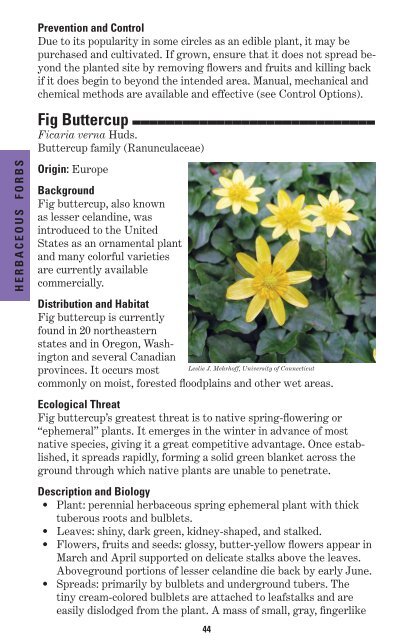Plant Invaders of Mid-Atlantic Natural Areas - National Park Service
Plant Invaders of Mid-Atlantic Natural Areas - National Park Service
Plant Invaders of Mid-Atlantic Natural Areas - National Park Service
Create successful ePaper yourself
Turn your PDF publications into a flip-book with our unique Google optimized e-Paper software.
HERBACEOUS FORBS<br />
Prevention and Control<br />
Due to its popularity in some circles as an edible plant, it may be<br />
purchased and cultivated. If grown, ensure that it does not spread beyond<br />
the planted site by removing flowers and fruits and killing back<br />
if it does begin to beyond the intended area. Manual, mechanical and<br />
chemical methods are available and effective (see Control Options).<br />
Fig Buttercup _____________________________<br />
Ficaria verna Huds.<br />
Buttercup family (Ranunculaceae)<br />
Origin: Europe<br />
Background<br />
Fig buttercup, also known<br />
as lesser celandine, was<br />
introduced to the United<br />
States as an ornamental plant<br />
and many colorful varieties<br />
are currently available<br />
commercially.<br />
Distribution and Habitat<br />
Fig buttercup is currently<br />
found in 20 northeastern<br />
states and in Oregon, Washington<br />
and several Canadian<br />
provinces. It occurs most Leslie J. Mehrh<strong>of</strong>f, University <strong>of</strong> Connecticut<br />
commonly on moist, forested floodplains and other wet areas.<br />
Ecological Threat<br />
Fig buttercup’s greatest threat is to native spring-flowering or<br />
“ephemeral” plants. It emerges in the winter in advance <strong>of</strong> most<br />
native species, giving it a great competitive advantage. Once established,<br />
it spreads rapidly, forming a solid green blanket across the<br />
ground through which native plants are unable to penetrate.<br />
Description and Biology<br />
• <strong>Plant</strong>: perennial herbaceous spring ephemeral plant with thick<br />
tuberous roots and bulblets.<br />
• Leaves: shiny, dark green, kidney-shaped, and stalked.<br />
• Flowers, fruits and seeds: glossy, butter-yellow flowers appear in<br />
March and April supported on delicate stalks above the leaves.<br />
Aboveground portions <strong>of</strong> lesser celandine die back by early June.<br />
• Spreads: primarily by bulblets and underground tubers. The<br />
tiny cream-colored bulblets are attached to leafstalks and are<br />
easily dislodged from the plant. A mass <strong>of</strong> small, gray, fingerlike<br />
44

















